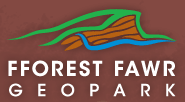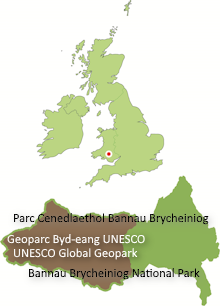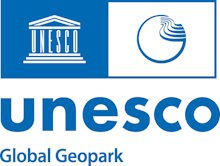(about 2750 – 2000 years ago)
Historians use the term ‘Iron Age’ to define the last phase of prehistory which ended with the Roman conquest. A knowledge of iron working had reached Britain by around 2750 years ago. The earliest date for an iron artefact from S Wales is 2600 years ago.
Assaults on the wildwood which had spread across Britain after the Ice Age continued through the Iron Age. Once cleared of trees during the Bronze Age, the upland heather moorland was used by Iron Age people for common grazing. There is also evidence for arable agriculture. Indeed the general pattern of today’s upland landscape was probably put in place at this time.
The archaeological evidence for the Iron Age period is poorly understood. This is in part due to the absence of radiocarbon dates for field monuments although the very recently developed technology of cosmogenic dating of stone surfaces may soon provide us with useful dates. It is possible that some standing stones, cairns and hut circles and even burnt mounds date from the Iron Age but some may well be older. The first hill forts in Wales may in fact be Bronze Age in date.
Iron Age hillforts along the Usk Valley
A series of forts dating to the Iron Age crown hills on either side of the Usk Valley west of Brecon. Many are accessible to the public and are briefly described below.
Pen-y-crug
(OS grid ref: SO 039303)
This Iron Age hillfort lies about 3km north-west of Brecon. The hill itself rises to 331m above sea level. It measures 180m north to south and 135m east to west. The site can be accessed on foot along either of two public rights of way leading out of the town or else by means of a short path from the summit of the minor road which runs east from Cradoc village. There is parking space for a few cars off the road here (OS Grid ref: SO 028309) The whole site is owned by the National Park Authority and is ‘open access’.
Also of interest on the site are the remains on the eastern slopes of a Victorian brick and tile works.
Nearby Iron Age sites:
- Slwch Tump
- Coed Fenni-fach
- Y Gaer
Other nearby historic/prehistoric sites:
- Y Gaer Roman Fort
Slwch Tump
(OS grid ref: SO 056284)
An Iron Age hillfort immediately north of Brecon which can be accessed via Slwch Lane which runs east-west to the north of the site and from which a public footpath loops around the outside of the single stone/earth rampart. Its form is rather more obscured by trees and hedges than its neighbour Pen-y-crug.
Nearby Iron Age sites:
- Pen-y-crug
- Coed Fenni-fach
- Y Gaer
Other nearby historic/prehistoric sites:
- Y Gaer Roman Fort
Coed Fenni-fach
(OS grid ref: SO 014294)
A small fort which sits atop the wooded hill 3km west of Brecon. There is currently no public access to the site.
Nearby Iron Age sites:
- Slwch Tump
- Pen-y-crug
- Y Gaer
Other nearby historic/prehistoric sites:
- Y Gaer Roman Fort
Y Gaer
(OS grid ref: SN 922263)
This hillfort lies about 2.5km south of Sennybridge. A public right of way (Heol Cefn-y-gaer) runs north-south past the site. The hill which rises to a height of 343m is composed of mudstones and siltstones of the St Maughan’s Formation which include numerous bands of sandstone some of which have been quarried.
Nearby Iron Age sites:
- Slwch Tump
- Pen-y-crug
- Coed Fenni-fach
Other nearby historic/prehistoric sites:
- Y Gaer Roman Fort
Twyn y Gaer
(OS grid ref: SN 990280)
This hillfort lies about 5km west of Brecon at the northern end of a strip of common land owned by Brecon Beacons National Park Authority. There is open access to the site. A public right of way (Heol Cefn-y-gaer) runs north-south past the site. The hill which rises to a height of 367m is composed of mudstones and siltstones of the St Maughan’s Formation which include two or three bands of sandstone. Ripple marks can be seen in the quarried slabs of the uppermost band near the trig point which crowns the hill.
Of rather later origin are a series of ‘pillow mounds’ on the southern and eastern flanks of the hill. These low mounds were provided in connection with the breeding of rabbits in recent centuries.
Nearby Iron Age sites:
- Slwch Tump
- Pen-y-crug
- Coed Fenni-fach
- Y Gaer
Other nearby historic/prehistoric sites:
- Y Gaer Roman Fort
- Sarn Helen Roman road
- Standing stones & Bedd Gwyl Illtud on Mynydd Illtud
Further reading
‘Prehistoric sites of Breconshire’ Monuments in the Landscape series vol 9. Children G. & Nash G. Logaston Press



